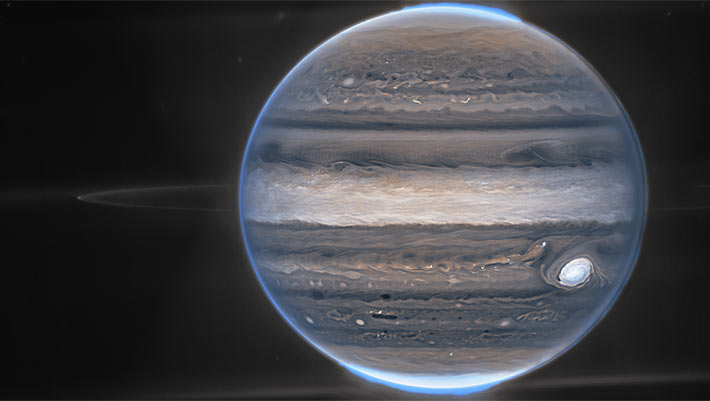The two new images of Jupiter were taken with Webb’s Near-Infrared Camera (NIRCam), which has three specialized infrared filters that showcase details of the largest planet in the Solar System.
This NIRCam/Webb image from two filters — F212N (orange) and F335M (cyan)– shows the Jupiter system. Image credit: NASA / ESA / CSA / Jupiter ERS Team / Ricardo Hueso, UPV & EHU / Judy Schmidt.
“We hadn’t really expected it to be this good, to be honest,” said Professor Imke de Pater, an astronomer at the University of California, Berkeley.
“It’s really remarkable that we can see details on Jupiter together with its rings, tiny satellites, and even galaxies in one image.”
In the wide-field view of Jupiter, Webb captured the gas giant with its faint rings and two tiny moons called Amalthea and Adrastea.
The fuzzy spots in the lower background are likely galaxies photobombing this view.
“This one image sums up the science of our Jupiter system program, which studies the dynamics and chemistry of Jupiter itself, its rings, and its satellite system,” said Professor Thierry Fouchet, an astronomer at Paris Observatory.
This NIRCam/Webb image from three filters — F360M (red), F212N (yellow-green), and F150W2 (cyan) — shows Jupiter. Image credit: NASA / ESA / CSA / Jupiter ERS Team / Judy Schmidt.
In the standalone view of Jupiter, created from a composite of several images from Webb, auroras extend to high altitudes above both the northern and southern poles of the giant planet.
The aurorae shine in a filter that is mapped to redder colors, which also highlights light reflected from lower clouds and upper hazes.
A different filter, mapped to yellows and greens, shows hazes swirling around the northern and southern poles.
A third filter, mapped to blues, showcases light that is reflected from a deeper main clou

